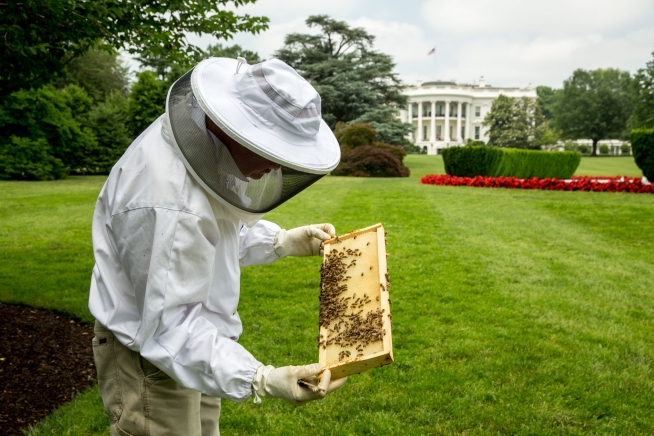
If you stand still, bees are less likely to sting you. Being calm helps bees see you as non-threatening. Sudden movements near hives can startle them. Some bees are naturally aggressive, so it's best to move away slowly. Bee venom composition affects how your body reacts. Allergies and sting location play a role too. Remember, bees sting to defend their hive. Understanding their behavior can help you avoid stings. By staying calm and respecting their space, you can coexist peacefully. Want to learn more about bee communication and safety measures around bees?
Bee Behavior and Perception
When you stand still, bees perceive you as less of a threat and are less likely to sting. By holding onto the idea that stillness is key, you show the bees that you mean no harm, and they're more likely to go about their business without feeling the need to defend themselves.
It's like a peaceful coexistence - you respect their space, and they respect yours. This mutual understanding can help you avoid unnecessary confrontations with these buzzing creatures.
Factors Influencing Bee Sting Response
When it pertains to bee stings, factors like bee venom composition and individual allergic reactions play an essential role in determining your body's response.

Some people may have severe reactions due to allergies, while others might experience milder symptoms.
Understanding these factors can help you prepare and respond appropriately in case of a bee sting.
Bee Venom Composition
Understanding the composition of bee venom is essential in determining the factors that influence your response to a bee sting. Bee venom is a complex mixture of proteins, peptides, and enzymes. One of the key components is melittin, a peptide that causes pain and inflammation. Phospholipase A2 is another important enzyme that contributes to the venom's inflammatory effects. Histamine and dopamine are also present, playing roles in allergic reactions and pain perception.
The amount of venom injected, the location of the sting, and your individual immune response all influence how your body reacts to a bee sting. By knowing what bee venom is made of, you can better understand why some people have mild reactions while others experience more severe symptoms.
Individual Allergic Reactions
To better understand how individual allergic reactions are influenced by bee stings, consider the factors that play an important role in determining your body's response.
- Genetics: Your genetic makeup can predispose you to be more or less sensitive to bee venom. Previous Exposures: The more times you've been stung, the more likely you're to develop an allergy. Overall Health: Your general health condition can impact how your body reacts to a bee sting. Immune System: The strength of your immune system plays an essential role in determining your response to bee venom.
Myth: Bees Only Sting Moving Targets
You might've heard the myth that bees only sting moving targets, but the reality is that bees can also sting stationary objects, including unsuspecting humans.
Regardless of whether you're in motion or standing still, if a bee http://rowanflwa240.lucialpiazzale.com/can-i-raise-my-own-bees feels threatened or provoked, it may sting you in defense.
Bee Stings Stationary Targets
If you remain still, bees may still sting you. It's a common misconception that bees only target moving objects. Regarding bee stings, standing stationary doesn't grant you immunity.
Here are some key points to keep in mind:
- Bees can perceive stationary objects as threats, especially if you're close to their hive or nest. Some bees are more aggressive and may sting regardless of movement. Sudden movements can startle bees, increasing the likelihood of a sting. Remaining calm and slowly moving away from the bee's vicinity can help prevent stings.
Bee Stings Regardless
Even when standing still, bees may still sting you, proving false the myth that they only target moving objects. Bees will sting if they feel threatened, regardless of whether you're in motion or not. Their main goal is to protect their hive, so if they perceive you as a threat, they'll not hesitate to defend themselves.
It's important to remain calm and avoid swatting at them, as this may agitate them further. If you find yourself in the vicinity of bees, try to slowly and calmly move away to reduce the chances of getting stung. Remember, bees play an essential role in our ecosystem, so it's best to respect their space and coexist peacefully.
Bee Stings Based on Perception
Despite popular belief, bees don't exclusively target moving objects regarding stinging based on their perception. Bees can be triggered to sting by various factors, not just movement.
Here are some reasons why bees might sting you even if you're standing still:
- Scent: Bees are sensitive to strong scents, such as perfumes or sweat. Dark Colors: Dark clothing can make you appear like a predator to bees. Sudden Movements: While stillness mightn't trigger a bee, sudden movements can startle them. Protecting Their Hive: Bees will sting to defend their hive, regardless of your movement.
Understanding Bee Communication
To understand how bees communicate, observe their intricate waggle dance. Bees use this engaging movement to convey important information to their fellow hive members.
When a forager bee returns to the hive after finding a rich nectar source, it performs the waggle dance to communicate the location and quality of the food. By following the movements and interpreting the intensity and duration of the dance, other bees can determine the direction and distance to the food source.
This intriguing form of communication allows bees to efficiently share crucial information, contributing to the overall success of the hive. So next time you see a bee waggling away, take a moment to appreciate the incredible communication skills of these tiny but mighty insects.
Science Behind Bee Sting Aggression
The science behind bee sting aggression reveals fascinating insights into the factors influencing these insects' defensive behavior. Bees aren't out to get you for no reason; their actions are often driven by specific triggers.
- Protecting the Hive: Bees sting to defend their colony against perceived threats. Alarm Pheromones: When a bee stings, it releases alarm pheromones that signal danger to other bees. Sensitivity to Vibrations: Bees can sense vibrations, which may provoke defensive responses. Protecting Resources: Bees may sting if they feel their food or nest is under threat.
Understanding these factors can help you navigate bee encounters with more awareness and respect for these incredible insects.
Human Reactions to Bee Movement
Feeling a bee buzzing around you can often trigger instinctive reactions. Your heart might race, muscles tense, and your eyes dart around trying to locate the buzzing culprit. It's a natural response to feel a bit on edge when these tiny creatures zoom past you.
Some people may freeze, hoping the bee will go away on its own, while others might start swatting at the air in a panic. The movement of bees can provoke a range of reactions from humans, from curiosity to fear.
Understanding how you react to these buzzing insects can help you better prepare for potential encounters and stay calm in their presence.
Tips for Minimizing Bee Sting Risk
Minimize your risk of bee stings by wearing light-colored clothing and avoiding heavily scented perfumes or lotions. To further reduce the chances of getting stung, follow these tips:
- Stay calm and move away slowly if you spot a bee near you. Don't swat at bees or make sudden movements that can agitate them. Be mindful of where you place your hands and feet, especially when near flowers or beehives. If you see a bee flying around your food or drinks, cover them to prevent any unwanted visitors.
Importance of Remaining Calm
Keeping in mind that staying composed around bees is essential for minimizing the risk of getting stung. When you encounter these buzzing pollinators, bear in mind that they can pick up on your fear or agitation. By staying calm, you send a signal that you mean no harm, reducing the likelihood of a defensive reaction from the bees.
Panicking or making sudden movements can startle them and increase the chances of getting stung. Take a deep breath, relax your body, and try to move away slowly and smoothly if you feel uncomfortable. Being mindful of your emotions and maintaining a sense of tranquility not only keeps you safe but also respects the bees' space and purpose in the ecosystem.
Bee Sting Prevention Strategies
To prevent bee stings, maintain a calm demeanor and move slowly and smoothly when around these buzzing insects. Here are some strategies to help you steer clear of those sharp stings:
- Wear Light-Colored Clothing: Bees are attracted to dark colors, so opt for light-colored clothing when spending time outdoors. Avoid Fragrances: Skip the strong perfumes and scented lotions that might attract bees to you. Stay Away from Flowering Plants: Be cautious around blooming flowers, as bees are naturally drawn to them. Cover Food and Drinks: When eating outdoors, cover your food and drinks to prevent bees from being lured in by the smell.
Safety Measures Around Bees
When around bees, always remain calm and move slowly to reduce the likelihood of getting stung. Sudden movements can startle them, leading to defensive behavior. It's essential to wear light-colored clothing and avoid strong fragrances that may attract bees.
If you see a bee flying around you, try to stay still and avoid swatting at it. Remember, bees are vital for pollination and the environment, so it's best to coexist peacefully. If you're allergic to bee stings, always carry your prescribed medication with you.
Keeping a safe distance and being mindful of their presence can help you enjoy nature without any worries. By respecting their space and remaining calm, you can peacefully share the outdoors with these buzzing creatures.
Frequently Asked Questions
Can Bees Sting Multiple Times in a Row?
Buzzing bees bestow bountiful stings. Yes, bees can sting multiple times in a row. Their barbed stingers don't hinder them from striking repeatedly. So, steer clear of their path to stay safe and sting-free.
Do Bees Have a Sense of Smell?
Bees have an incredible sense of smell, guiding them to flowers and their hive. Their keen olfactory abilities help them communicate through pheromones and locate food sources. Trust https://pastelink.net/m0g73pem their scent-seeking prowess to navigate their world.
How Far Can Bees Detect Movement?
When bees detect movement, they can sense it from several feet away. Their ability to perceive motion helps them identify threats or potential food sources. Standing still may not always prevent a bee from noticing you.
What Colors Attract Bees the Most?
To attract bees, wear bright colors like yellow, blue, and purple. These shades mimic the flowers bees love. Avoid dark colors and black, as they can resemble predators. Bees are drawn to vibrant hues in your garden.
Are All Bees Able to Sting Humans?
Bees, in general, have the ability to sting humans. However, not all bees are aggressive and will only sting if they feel threatened. Remember, staying calm and still can often prevent a bee from stinging you.